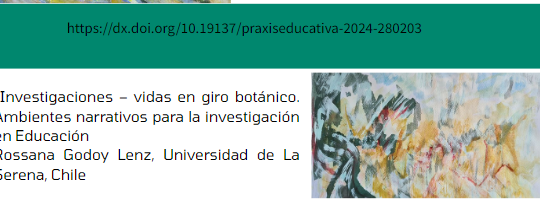Research-lives in a botanical turn. Narrative environments for research in Education
DOI:
https://doi.org/10.19137/praxiseducativa-2024-280204Keywords:
research-lives, plant life, living environments, research environments, educationAbstract
Through the recognition of the qualities of plants that promote life, the study proposes these characteristics as necessary for the generation of living environments in education and research. Autopoietically, we identify relationships of sensitivity, collaboration, movement, travel, communication, memory and care. We value these qualities for the learning, change and transformation environments necessary in Education, which constitute dynamic, self-organized, changing and complex environments that are recognized as narrative environments. This work contributes to the understanding of life-research as an investigative and narrative experience, which from bioinspired research models, makes research possible as an experience of life itself that happens in its future.
Downloads
References
Angulo, C. (2022). Algunas raíces del modelo bioinspirado. Utadeo.
Arendt, H. y Nanz, P. (2006). Entre el pasado y el futuro. Wagenbach.
Bauman, Z. (2002). Modernidad líquida. Fondo de Cultura Económica.
Butler, J. (1990). Gender trouble. Feminismo y subversion of identity. Routledge.
De Jesús, M., Andrade, R., Martínez, D. y Méndez, R. (2007). Re-pensando la Educación dese la Complejidad. http://www.redalyc.org/articulo.oa?id=30501602
Del Mastro Puccio, C. (2020). Lenguaje, narración y cultura de la vida: la realidad inmanente de lo humano en la fenomenología de Michel Henry. Cuestiones de Filosofía, 6(26), 29-51. https://doi.org/10.19053/01235095.v6.n26.2020.11214
Deleuze, G. y Parnet, C. (1998). Diálogos. Escuta.
Gaardner, J. (1991). El mundo de Sofía. Siruela
Galindo, C. y Kristeva, L. (2001). La vida como narrativa. El ge/lio femenino. La vida, la locura, las palabras. Paidós.
García, R. (2003). Método: pesquisa com os cotidianos. Cortes.
Godoy Lenz, R. (2021). Lo que nos interesa, aprendemos e imaginamos. Voces de la niñez en pandemia. Revista de educación,
Godoy Lenz, R. y Ribeiro, T. (2021). Chuva de estrelas: entre metáforas e narrativas para sentir/pensar caminhos investigativos desde nossas ancestralidades. Revista educação unisinos, 25, 3-14.
Godoy Lenz, R., Ramallo, F. y Ribeiro T. (2021). Investigaciones vivas de las experiencias educativas: escuchar, conversar e indagar. Colombia:Psicología y Educación.
Guedes, A. y Ribeiro, T. (2019). Pesquisa, Alteridade e experiência: metodologías minúsculas. Ayvu.
Haraway, D. (1995). Simios, cíborgs y mujeres: la reinvención de la naturaleza. Cátedra
Henry, S. (1987). Teoría del cuerpo subjetivo, en Michel H. Aportes para una fenomenología contemporánea del cuerpo. Universidad Chile.
Henry, S. (2007). Encarnación: Una filosofía de la carne. Prometeo.
Krenak, A. (2019). Ideias para adiar o fim do mundo. Companhia das letras.
Lispector, C. (2005). Aprendizaje o el libro de los placeres. Siruela.
Mancuso, E. (2015). El increíble viaje de las plantas. Debate.
Mancuso, E. (2017). Plant revolution. Le piante hanno già inventato il nostro futuro.
Titivillus.
Mancuso, E. (2017). Sensibilidad e inteligencia en el mundo vegetal. Siglo XXI.
Mancuso, E. (2018). El futuro es vegetal. Galaxia Gutenberg.
Mancuso, E. (2019). La nación de las plantas. Debate.
Maturana, H. (1995). Emociones y lenguaje en educación y política. Dolmen Ediciones.
Maturana, H. y Nisis, S. (1997). Formación humana y capacitación. Dolmen ediciones.
Ospina, H. y Murcia, N. (2012). Regiones investigativas en educación y pedagogía en Colombia. Zapata Manizales. http://www.cinde.org.co/pdf/regiones%20investigativas.pdf
Polland, M. (2001). La botánica del deseo. Random House.
Ricoeur, P. (1996). Sí mismo como otro: Ensayo de hermenéutica. Siglo XXI.
Ricoeur, P. (2006). La vida en busca de narrador. Papeles de Filosofía, 25(2), 9-22. Ágora.
Rivera Cusicanqui, S. (2018). Un mundo ch'ixi es posible: Ensayos desde un presente en crisis. Tinta Limón.
Rolnik, S. (1989). Cartografia sentimental: Transformacões contemporâneas do desejo. Estacão Liberdade.
Sedgwick, E. (2018). Tocar la fibra: Afecto, pedagogía, performatividad. Alpuerto.
Tompkins, P. y Bird, C. (1973). La vida secreta de las plantas. Harper & Row.
Varela, F. (2016). El fenómeno de la vida. J-C-Sáez.

Published
Issue
Section
License
Copyright (c) 2024 Rossana Godoy Lenz

This work is licensed under a Creative Commons Attribution-NonCommercial-ShareAlike 4.0 International License.
Copyright Notice
Editorial Committee Educational Praxis Magazine:
I hereby declare that I am the author of the article titled (article name), that it is original and my own and that it was not previously published in any other format or medium. I declare to know that the magazine will not charge me any type of fee under any circumstances, nor will I receive any type of monetary compensation If it were accepted for publication in Educational Praxis, I authorize the aforementioned magazine to publish it digitally and to advertise it on its social networks.
If the work is published, I adhere to the Creative Commons license called "Attribution - Non-Commercial Share Alike CC BY-NC-SA", through which it is allowed to copy, reproduce, distribute, publicly communicate the work and generate derivative works, as long as when the original author is cited and acknowledged. This license has been used since September 2018. In 2016 CC BY NC ND 4.0 was adhered to; and in the years 2017 and 2018 (January-August) CC BY NC 4.0.
This CC BY-NC-SA Share Alike license does not, however, permit commercial use of the work. As an author, the journal may establish additional agreements for the non-exclusive distribution of the version of the work published in the journal, it allows me to self-archive the published articles, in their post-print version, in institutional, thematic repositories, personal web pages or any other relevant use. with the recognition of having been first published in this journal.
Educational Praxis adheres to DORA (Declaration on Research Assessment) signed in San Francisco, California, on December 16, 2012, and to the Declaration of Mexico (Joint Declaration LATINDEX - REDALYC - CLACSO - IBICT).














_(1)2.png)


3.png)











_(2).png)






2.jpg)









